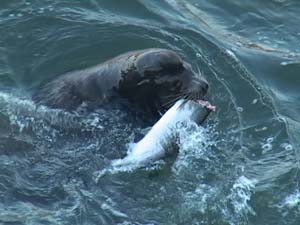forum
library
tutorial
contact

Sea Lion Killings: California Officials
Express Skepticism over Animal Deaths
by Susanne Rust
California Watch, April 10, 2012
|
the film forum library tutorial contact |

|
Sea Lion Killings: California Officials
by Susanne Rust
|
 A third salmon-eating California sea lion was captured and killed yesterday at the Bonneville Dam in Washington.
A third salmon-eating California sea lion was captured and killed yesterday at the Bonneville Dam in Washington.
Two sea lions were captured and chemically euthanized at the Columbia River dam by Washington state officials last week.
And while Oregon, Washington and federal wildlife officials say the killings are necessary to preserve endangered salmon populations, California officials expressed skepticism.
Citing predictions for record-high numbers of Chinook salmon this year along the Pacific coast, Andrew Hughan, a spokesman for the California Department of Fish and Game, said his agency was "perplexed" by the killings.
"We know salmon is a huge part of the Oregon economy, but is eliminating a couple of sea lions really going to make a difference?" Hughan said.
Officials estimate that a California sea lion eats about seven salmon a day. According to the Washington Department of Fish and Wildlife, the two California sea lions were captured and then chemically euthanized last week after ignoring repeated hazing techniques, such as fireworks and non-lethal explosives.
A federal law requires that sea lions targeted for death must be individually identifiable, have been observed eating salmon for five days (even if those days occurred over several years) and have not responded to hazing.
Craig Bartlett, a spokesman for Washington's Department of Fish and Wildlife, said his agency and Oregon's Department of Fish and Wildlife sought permission to kill the protected marine mammals because of the states' overriding concern for salmon.
"Yes, there are predictions that we will have record numbers of salmon this year, but that hasn't happened yet," he said.
The peak salmon run generally occurs toward the end of April and beginning of May. But because of recent rain, the rivers are swollen, and the salmon migration has been slow to start, Bartlett said.
"Our chief concern is the wild salmon," he said, which tend to migrate far up the river, to the Bonneville Dam. He said hatchery fish tend to split off onto tributaries further down the river.
According to Bartlett, 30 percent of the fish below the dam are wild.
The Humane Society of the United States filed a lawsuit last month against the National Oceanic and Atmospheric Administration, which authorized the states to kill the protected mammals. The society argued that the killings violate the Marine Mammal Protection Act and that the government has failed to show that sea lions, which are natural salmon predators, kill a significantly large number of salmon.
"Especially when you compare them to other sources of mortality," said Sharon Young, Humane Society marine issues field director. Young said sea lions have been documented to take anywhere between 0.4 percent and 4.2 percent of the salmon run, while commercial fishing is closer to 17 percent, and the dam takes about 10 percent.
Young added that the states' stocking of non-wild fish, such as bass and walleye, in the river has had a significant impact on the survival of salmon. The non-wild fish eat small or juvenile salmon.
And in any case, she added, the salmon run has been stable or growing over the past several years.
"There is just no justification for killing the sea lions," she said. "It's just a red herring. It looks like something easy to solve, but they should really be addressing the bigger issues, like non-native fish."
The society also sought a temporary restraining order to prevent the killings, but that order was rejected by a federal judge. Currently, the states are authorized to kill up to 92 sea lions per year for the next five years. However, in response to the Humane Society's suit, a judge ruled that only 30 could be killed this year.
Related Sites:
NOAA Authorizes States To Remove Sea Lions That Threaten Protected Salmon ENews Park Forest, 3/15/12
Related Pages:
Not Many Sea Lions, But Two 'Individually Identifiable' Salmon Eaters Trapped, Killed by Staff, Columbia Basin Bulletin, 4/6/12
www.bluefish.org / ecologic / predation / sea lions
learn more on topics covered in the film
see the video
read the script
learn the songs
discussion forum
